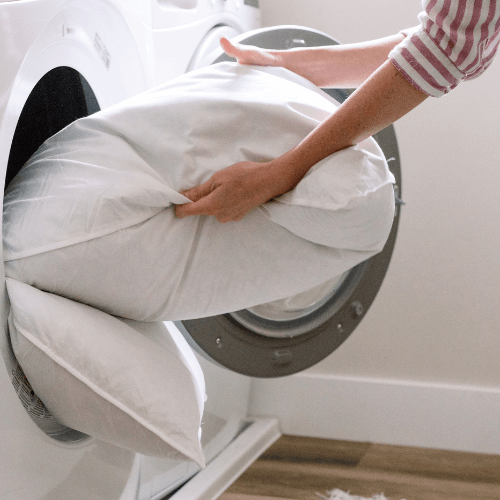Are you tired of feathers seeping out of your pillow? Does the constant mess drive you crazy? You don’t have to keep dealing with this problem. With a few simple steps, you can prevent your feather pillow from leaking any more feathers.
Feather pillows can be both comfortable and luxurious, but they come with a big downside: they tend to leak feathers. It’s not only annoying, but it can also be dangerous for those who suffer from allergies or asthma.
Fortunately, there are ways to stop your pillow from leaking any more feathers.
If you want to get rid of the mess and keep your pillow in top condition, then follow these steps to stop those pesky feathers from escaping.
1. Identify The Source Of The Feathers

The sight of feathers floating around our living space can make us feel like we’re living in a snow globe.
If you’ve noticed the fine, white fluff around your room, it could be coming from your feather pillow. It’s time to take action and stop the mess!
The first step is to identify the source of the feathers.
It’s important to examine the pillow for rips or tears. Feathers can escape through any holes or weak spots in the fabric.
Once you know where they’re coming from, you can take measures to fix it.
Check all sides of your pillow for any visible signs of damage that may have caused the leakage.
You can also check how soft the pillow is; if it feels lumpy or has lost its shape, this might mean that more feathers have escaped than usual and need to be replaced with new ones.
Once you’ve identified where the feathers are coming from, you’re ready to move on to fixing them up and restoring your pillow to its former glory.
2. Prepare Your Pillow For Cleaning
Coincidentally, the pillow in my arms was leaking feathers. I had to find a solution soon – it was too much of a mess. It was time to prepare the pillow for cleaning.
There were three steps to follow:
- Remove all feather particles from the surface of the pillow
- Vacuum the pillow with a hose attachment
- Place the pillow in an area where it can be aired out and dried.
I got to work, taking every feather particle off my pillow until it was completely clean.
Then I vacuumed it with a hose attachment and placed it somewhere where it could air out and dry quickly.
The process wasn’t difficult, but it took time and effort to make sure that no feathers were left behind.
By following these steps, I knew that my pillow would stay cleaner longer if I cleaned it regularly.
3. Clean Feather Pillows Regularly

Cleaning a feather pillow is like giving your soul a much needed vacation. Just like a tired mind needs to stop and rest, so too does the feather pillow.
It’s essential to clean it regularly to keep it in good condition.
As with any cleaning routine, there are some things to keep in mind when tackling the task of keeping feathers from leaking out of the pillow.
First and foremost, be sure that the feather pillow is not wet or damp before beginning the cleaning process.
If so, allow it to dry completely until no moisture remains.
Then, use a vacuum cleaner with an upholstery brush attachment to gently suction away dust, dirt and debris from the surface of the pillow.
Make sure to move around all areas of the pillow for best results.
Afterwards, pour baking soda over the entirety of the feather pillow and let sit for at least an hour before vacuuming again with the upholstery brush attachment.
This will help further remove dirt and odor-causing bacteria from within its depths.
Finally, fluff up your feather pillow by shaking it up vigorously for several minutes or until all its feathers are evenly distributed throughout its core once more.
This will give you a renewed sense of comfort that you can enjoy night after night while also preventing feathers from ever leaking out again – unless you’ve got an issue with ripped seams or stitching that needs attention; but more on that later…
4. Repair Pillow Seams And Stitches
Repairing pillow seams and stitches is a necessary step to prevent feathers from leaking.
Feather pillows tend to have weak stitching, so the seams need reinforcing. Sew a few rows of stitches around the edges of the pillow, as well as along any seams or cuts in the fabric.
This’ll help keep all the feathers inside.
Take care not to overstuff it though – if your pillow’s too full, you’ll make it harder for air to escape and will end up with lumpy patches.
You should also check for any holes or tears in the fabric that could be allowing feathers to escape.
If you find any, patch them up with some strong fabric glue or adhesive tape.
Make sure you cover both sides of the hole or tear so no more feathers can get out.
Keeping your feather pillows clean and repairing any damage is important if you want to stop them from leaking feathers.
With regular maintenance, you can make sure your pillows stay in good condition and no longer leak feathers.
Now that you know how to repair a feather pillow, it’s time to consider replacing it altogether.
5. Consider Replacing Your Pillow
Replacing your pillow may be the best option if feathers are leaking. It’s an easy way to ensure the problem won’t happen again.
Before you do, however, there are a few things to consider.
First, figure out why the feathers are coming out in the first place. Is it because of poor craftsmanship or simply old age?
It’s important to know what caused the issue so that you can make sure it doesn’t happen again with a new pillow.
Also, think about how much use your feather pillow has had over the years. If it’s been used for a long time, then replacing it is almost certainly necessary.
But even if not, getting a new one could be beneficial since the quality of your sleep will likely improve with a newer and better-made pillow.
Finally, decide whether you want to get another feather pillow or switch to another type of pillow altogether.
This decision comes down to personal preference and comfort level with different types of materials and fillings.
Make sure that whatever you choose has a quality liner as well so that feathers don’t leak from your new pillow either!
6. Choose A Feather Pillow With A Quality Liner
Picture a room full of soft, fluffy pillows. They can be the perfect addition to any bedroom, providing plush comfort and support for your head and neck.
But if you’re not careful, those same pillows can become a source of frustration when feathers begin to escape and leak out everywhere.
Fortunately, there are steps you can take to prevent this from happening.
One such step is to choose a feather pillow with a quality liner. A good liner will help keep feathers inside the pillow and reduce the amount that escapes over time.
It’s also important to check the label for details about how often the liners should be replaced to ensure maximum performance.
This will ensure that you enjoy your feather pillows for years to come without pesky leaks!
When selecting a quality liner, look for one made of durable material like cotton or polyester blend.
These fabrics are designed to stand up to regular washing and wear-and-tear better than other materials, reducing the chance of tears or rips that could lead to leaking feathers.
Plus, these fabrics are also breathable so they don’t trap heat or moisture like plastic liners do, making them more comfortable for sleeping on during hot summer nights.
TIP: When shopping around for liners, consider purchasing several at once so that you always have spares on hand in case one needs replacing sooner than expected!
7. Wash Feather Pillows With Care

It’s like a feathery tornado has exploded in your bedroom. Feathers have gone everywhere, and you can’t seem to get it under control.
Washing your feather pillow is the key to stopping the feathers from getting all over the place.
Taking care when washing your feather pillow is essential to keep it from going off balance and unleashing more feathers into the world.
You’ll want to start by removing any excess feathers with a vacuum or a lint roller.
Then, put the pillow in a large mesh bag or pillowcase and tie it closed before running it through a gentle cycle on cold water with a mild detergent.
Once finished, avoid wringing out the pillow; instead, press out excess moisture with a towel and let air-dry completely before using again.
Following these steps will help maintain the shape of your feather pillow and reduce leakage of feathers for years to come.
With proper care, you can enjoy your coziest sleep without any flocks of feathers flying around!
8. Dry Feather Pillows Properly
Finally, we have come to the last step in our quest to stop feather pillows from leaking: drying them properly. Oh, the irony!
Surely it’s no surprise that the final piece of the puzzle is one of the most important steps.
Drying feather pillows is easy but needs to be done carefully. Tumble dry low or line dry, depending on your pillow’s instructions.
If a pillow can’t be machine dried, use a fan to speed up air circulation and help with drying time.
Make sure there’s plenty of airflow so moisture can escape and feathers don’t become matted or clump together.
Remember that taking good care of your pillows will ensure they last longer and keep their shape without leaking feathers all over your bed–and floors!
So take care when drying your feather pillows and you’ll enjoy many cozy nights’ sleep for years to come.
Ready for the next step? Let’s store these comfy babies in a clean place…
9. Store Feather Pillows In A Clean Place
Feather pillows can be a luxurious addition to any bedroom, but they come with the potential downside of feathers leaking out.
To avoid this, it’s important to store them in the right place.
Think of your feather pillow like a child: without the right environment and proper care, it won’t thrive.
Just as you would want your child to grow up in a clean and nurturing home, so too should your feather pillow be stored in a safe and clean space.
For example, if you keep your feather pillow in an attic or basement where there are pests or dampness, then that could cause the feathers inside to start leaking out.
This is why it’s essential to store your feather pillow in an area with no dust mites and away from any moisture or extreme temperatures.
Keeping it protected will make sure it lasts for years and doesn’t lose any of its softness or comfort over time.
By taking these simple steps when storing your feather pillow, you can help ensure that all its contents stay intact – no matter how much tossing and turning you do at night!
10. Invest In Allergy-Friendly Pillows
Feather pillows are like soft, cloud-like blankets of comfort.
But when they start to leak feathers, the comfy ambiance quickly turns chaotic.
To limit the mess that comes with feather pillows, investing in an allergy-friendly option can be a great solution.
Allergy-friendly pillows are great for those who suffer from allergies and asthma.
They provide a safe and comfortable sleep environment without the worry of allergens or dust mites.
Plus, they don’t shed feathers, meaning no more clean up after every nap or slumber.
These pillows are also made of materials that last longer than traditional feather pillows, ensuring you get your money’s worth out of them.
So if you’re looking for a way to make sure your pillow won’t leak feathers any time soon, allergy-friendly options can do just that!
Frequently Asked Questions
What Should I Do If I’m Allergic To Feathers?
Allergies can be a real nuisance. If you have allergies to feathers, your feather pillow is not a good choice. You need to take steps to protect yourself from the allergens.
First, consider replacing your feather pillow with something hypoallergenic, such as down alternative or memory foam.
These materials are designed to resist dust mites and other allergens, so they are much better for people with allergies.
You can also buy special covers for your feather pillow that will help contain the feathers and prevent them from leaking out.
Look for covers made of tightly woven material that won’t let any feathers escape. This should help keep you safe from allergens while still allowing you to keep your favorite pillow.
No matter what type of pillow you use, it’s important to make sure it stays clean and free of dust mites and other allergens.
Regularly washing and drying the cover can help keep your pillow in top condition and minimize the risk of an allergic reaction.
How Often Should I Clean My Feather Pillow?
Feather pillows can be a great addition to any bedroom, providing comfort and a cozy atmosphere. But if not taken care of properly, these pillows can start to leak feathers and become an eyesore.
To avoid such an issue, it’s important to know how often to clean your feather pillow. Like any fabric item, frequent use can cause the feathers in the pillow to become disheveled and matted.
To prevent this from happening, you should aim to clean your feather pillow every 1-3 months. This will ensure that all the feathers remain fluffy and intact. If you don’t have time for a full-on cleaning session, simple spot-cleaning with a damp cloth or vacuum cleaner may suffice.
Regularly cleaning your feather pillow is also important for health reasons. It helps keep dust mites and other allergens at bay which can cause respiratory problems if left unchecked.
With regular cleaning, you’ll be able to enjoy the comfort of your feather pillow without fear of allergies or leaking feathers.
What Are The Best Methods For Storing Feather Pillows?
Storing feather pillows is key to keeping them from leaking feathers. It’s important to do this correctly, as improper storage can lead to unwanted messes. Taking the right steps can ensure that your pillow stays in good condition and doesn’t lose its shape or fluffiness.
First, it’s essential to keep your feather pillow in a breathable bag. This will help protect the feathers inside, preventing dirt and dust from getting into the pillow.
It also ensures that moisture won’t be able to accumulate, which can cause the feathers to clump together and lose their shape over time. Finally, make sure you store your feather pillows in a cool, dry place away from direct sunlight.
Sunlight and heat can cause the feathers to break down faster, leading to them losing their softness and fluffiness quicker than normal. Additionally, storing them away from moisture helps prevent mildew or mold growth on the feathers.
Keeping all these tips in mind will help you maintain your feather pillows for a long time.
What Is The Best Way To Repair A Pillow Seam?
Storing feather pillows is one thing, but what happens when a seam starts to come undone?
Perhaps the feathers have started to escape, or the stuffing is starting to seep out. It doesn’t have to be a daunting task though – repairing a pillow seam can be surprisingly easy!
One of the best ways to repair a pillow seam is with an iron and some fabric glue. Taking a piece of fabric large enough to cover the torn area, spread some fabric glue over both sides.
Then, place the fabric over the ripped area, and press down with an iron set on low heat for about two minutes. Let it cool for fifteen minutes, then turn your pillow over and repeat on the other side.
This simple trick can save you from having to buy an entirely new pillow! With just a few basic supplies and knowledge of how much heat your particular type of fabric can withstand, you can be sure that your feather pillow will stay in tact.
No more worrying about feathers escaping or stuffing spilling out – just secure stitching and a comfortable snuggle companion once again!
Are There Any Special Instructions For Washing Feather Pillows?
Washing feather pillows requires special care. They need to be handled differently than standard pillows. With the right techniques, their feathers can stay contained and pillow life can be extended.
First, use a mild detergent and cold water. Don’t overload the washer with too many pillows, as this will reduce the effectiveness of the cleaning process. Also use a gentle cycle and a slow spin cycle when washing your feather pillows.
Next, air dry them instead of using a dryer. Drying them in the sun or on low heat is best for preserving feathers and shape.
Make sure you fluff them occasionally – or even better, stuff them with clean towels – while they’re drying to keep their shape and help prevent clumping.
Lastly, pay attention to signs of wear and tear like broken seams or leaking feathers. If they are in need of repair, consider mending them by hand or replacing them with new ones altogether to ensure your pillow remains fluffy and feather-free for years to come.
Conclusion
I know how frustrating it can be when your feather pillow starts leaking feathers.
I’ve been there before.
But don’t worry – with a few simple steps, you can stop the feathers from flying and keep your pillow in top condition.
First, if you’re allergic to feathers, invest in a hypoallergenic pillow alternative. Then, clean your feather pillow regularly to keep dust mites away.
Store the pillows properly to prevent damage, and repair any seams that have come apart.
Finally, when washing the pillows, follow the special instructions for feather pillows to avoid clumping or damage.
By following these tips, you can make sure your feather pillows last longer and remain comfortable throughout their life span.
So don’t give up on that old pillow – take action and make it as good as new!





